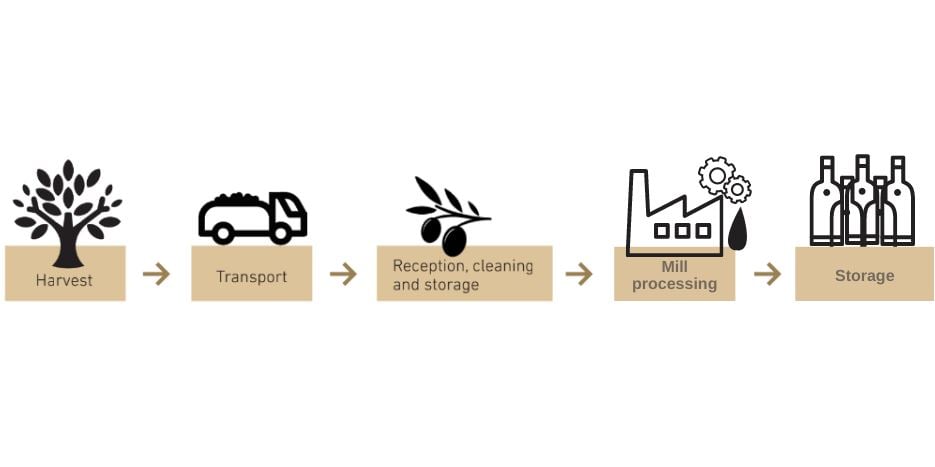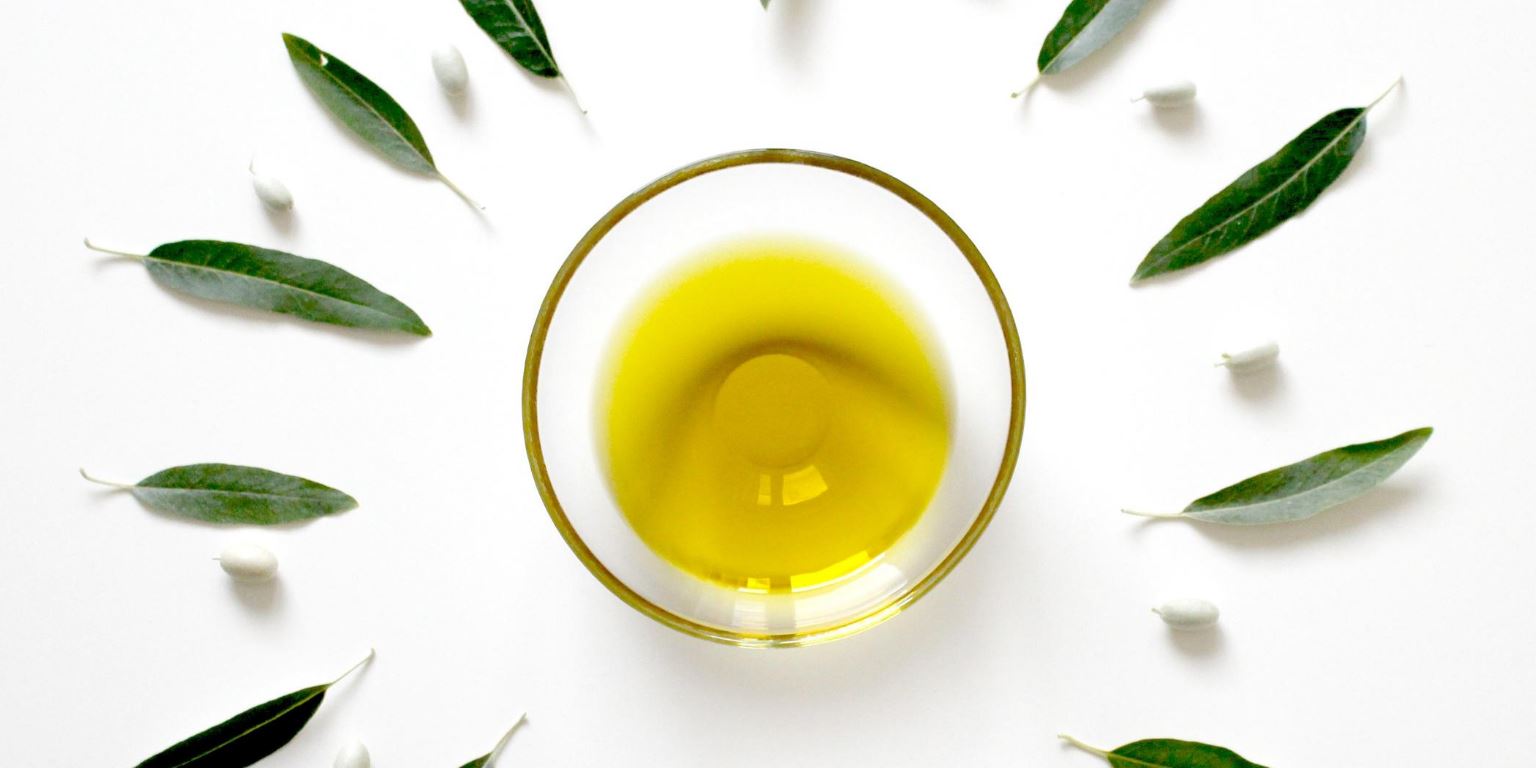Listen to this article
Known for its health benefits as a key component of the Mediterranean diet, Extra Virgin Olive Oil (EVOO) is a natural juice of a fruit, the olive.
Extra virgin olive oil is the highest olive oil quality, an oil with irreproachable qualities and properties that make it an ideal product for the kitchen and excellent for our health and one of the healthiest fats that exist.
In order to obtain high quality EVOO there are multiple factors to take into account. We can say it is a 10 step process.
1. Caring for the olive grove, olive tree and olives
2. Harvesting the olives
3. Transport and unloading
4. Washing and weighing the olive
5. Grinding and grinding
7. Solid-Liquid Separation. Horizontal centrifuge or decanter
8. Separation: liquid-liquid. Vertical Centrifuge
9. Decantation
10. Filtering
10+1: Storage
1. Caring for the olive grove, olive tree and olives
To obtain an extra virgin olive oil it is important to take care of the olive tree and olive grove throughout the year, in addition to having a climate that helps the good development of the fruit.
When we talk about quality in the process of making EVOO, we have to know that quality begins in the field, in the olive tree and in the olive.

2. Harvesting the olives
One of the key factors to produce an extra virgin olive oil is the olive harvest, since taking care of this phase of the production process is essential so that the olives arrive in good condition at the mill. To be of quality extra virgin olive oil, it must come, necessarily, from olives harvested from flight, that is, it does not come into contact with the ground, as this guarantees that the fruit reaches the next phase of the healthy process: to be clean and without impurities.
3. Transport and unloading
Both the collection and the transport must be done with the utmost care so that the olive does not suffer any damage. The transport of the fruit from the olive grove to the oil mill must be carried out on the same day of harvest, or as soon as possible, since the speed with which the process is carried out is fundamental and ultimately determines the quality of the final oil.
Once the olive is in the oil mill, it can be divided according to its variety, sanitary status, etc. The masters and technicians of the oil mill make a first selection of the olives that will be used for the production of EVOO and will differentiate the items according to the qualities.
4. Washing and weighing the olive
When the olives arrive at the oil mill, they are separated from both the leaves and the branches through fans. After this first cleaning, the olive can undergo a brief washing, if the master of the mill considers it to be so before weighing it, since each farmer must know the number of kilos of olives that he has delivered to the mill. It is important to wash the olives only if necessary, and the water must always be clean.
5. Grinding and grinding
Subsequently, it goes to grinding, that is, the process by which the olive is crushed to extract the oil. In most oil mills, stainless steel hammer mills are used to tear the cell membranes of the olives, releasing the oil globules. The olives must be ground the same day they are harvested to achieve maximum quality and prevent the fruit from deteriorating. Only in this way is a quality extra virgin olive oil obtained.
Grinding machines. Photos by ESAO
6. Paste beating
Paste beating process. Photo by ESAO
Next, the paste resulting from the grinding is beaten to gather the largest number of drops of oil dispersed in the ground mass. This step must be carried out cold, specifically below 27º. Temperature is crucial to guarantee the quality of EVOO.
Oil mills usually have thermobilters that generally consist of horizontal semi-cylindrical vats that have an outer chamber through which hot water circulates to keep the paste at the expected temperature. Inside the mixer, the olive paste is kept moving in a device that rotates around an axis.
7. Solid-Liquid Separation. Horizontal centrifuge or decanter
In this process, the oil is separated from the olive (pulp + vegetation water) by the effect of centrifugal force that increases the differences between the specific densities of the oil and the “alperujo” (solid matter plus the vegetation water). This operation is carried out in a horizontal centrifugal decanter. As the oily phase that comes out of the centrifuge can carry solid particles, it is convenient to have a vibrating screen at the oil outlet to separate the small pieces of pulp or bone.
The machine that does this step is called a horizontal centrifuge or decanter.
It is important that in this step the dough is not heated either, since as we have said, the high temperature does not favor the quality of the oils.
Decanter. Photo by ESAO
8. Separation: liquid-liquid. Vertical Centrifuge
Next, once the oil is separated from the solid part and a large part of the vegetation water, we subject it to a new centrifugation, where the oil is cleaned, separating it from the moisture that may remain from the previous phase, and removing fine solids. considered impurities.
It is about clarifying the oil or cleaning it to the maximum.
It is necessary to remove all possible moisture from the oil, since the moisture ferments and causes bad odors that will affect the quality of the oil.
The cleaner and filtered we keep the oil the better.
Vertical Centrifuge. Photo by ESAO
9. Decantation
After this centrifugation, decantation is carried out, a purely physical process by which the oil is separated from the water and the impurities (small olive particles) that have not been separated in the centrifugation processes. In decantation, the oil remains at rest for a few hours so that the remaining microparticles in suspension after centrifugation and residual moisture are deposited as a quality guarantee measure.
It is good that the settling tanks have a conical bottom to facilitate purging and cleaning.
Decanter deposit. Photo by ESAO
10. Filtering
It is important, once we have obtained the clean oil from the vertical centrifuge, pass it through a filter so that the resulting liquid is completely free of particles or moisture.
Filtering will help the oil last longer and not spoil quickly.
In case of having an unfiltered oil, it is important to consume it as soon as possible.
Filtering process. Photos by ESAO
10+1: Storage
Once the olive oil is clean we can add a last step to consider: storage. The oil goes to the cellars formed by stainless steel tanks.
There are numerous sizes of tanks.
It is good to have small deposits to work on quality and to be able to play around with the batches that you have.
The cellar must be protected from light and air.
The temperature of the cellar is between 15 and 18º. The conditions in which the oil remains in the cellar are important for the quality to remain intact.
The cellar must be ventilated and is advised not to have not have large windows.
It is important that the cellar is separated from intense or undesirable odors so that aromas are not transferred to the oils.
Olive Oil cellars. Photo by ESAO
Making sure to follow all the above steps and following the International Olive Council (IOC) best practices is esencial to produce good olive oil. During the entire production process there has to be two major things taken into consideration in order to obtain a high quality extra virgin olive oil. The first one is to ensure that high temperatures are not reached throughout the process and the second and is to have an exhaustive cleaning.
.png)



